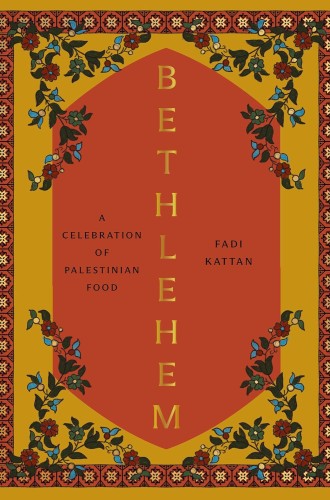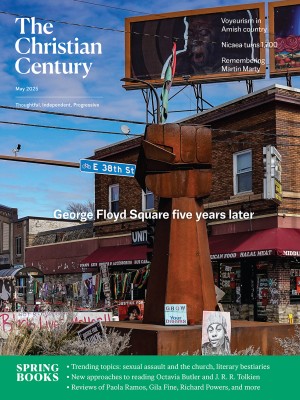The flavors of Bethlehem
Fadi Kattan’s cookbook is the story of a city told through its food. It’s also a quiet testament to faith.

Bethlehem
A Celebration of Palestinian Food
The first time I finally managed to cook zucchini flowers stuffed with fresh cheese, it was because of a gift. For months, I had been poring over the recipes in Fadi Kattan’s wonderful new cookbook, Bethlehem: A Celebration of Palestinian Food. That’s in part because I live in the Holy Land, and I buy my fruits and vegetables every Saturday from the same market in Bethlehem that stands at the heart of Kattan’s book. Yet time and time again, I couldn’t get up the courage to attempt his recipe for stuffed zucchini flowers, fearing the buds would fall apart. Every Saturday, I asked the vegetable vendors about their flowers, as if in wait.
Then, one Saturday morning, a vendor showed me that he had lovingly removed the yellow flowers from the zucchinis that he was selling so he could offer them to me as a gift. I accepted and immediately returned home and followed Kattan’s suggestion, stuffing them with fresh Nabulsi cheese and frying them. For the first time in my life, I ate the tender flowers. By then it was no longer about food. It was about gratitude.
Read our latest issue or browse back issues.
In Bethlehem cooking and eating are always about relationships, and it is this world of human connections that Kattan, himself a proud Bethlehemite, has lovingly brought to life. The result is not only a cookbook, but the story of Bethlehem told through its food.
Kattan, a French-trained chef who has recently opened restaurants in London (Akub) and Toronto (Louf), is renowned globally for his haute cuisine as well as his modern takes on Palestinian classics. Here, in his homage to his hometown, he combines seasonal recipes with photographs of the farmers and artisans who provide the town its sustenance. Moving through the seasons, readers are invited to fry eggs with samneh (clarified butter) and sumac in springtime, to make apricot baklawa during the brief apricot season in summer, to compose a salad of freekeh (roasted green wheat) in autumn, and bake his grandmother’s Christmas cake come wintertime. To read this book is to take a yearlong pilgrimage through a community and the food it loves.
At the center of Kattan’s book is the Bethlehem market, only a five-minute walk from the nearby Basilica of the Nativity, where tradition holds that Jesus was born. For locals, the basilica and the market together form the beating heart of Bethlehem’s town center. For generations, butchers, farmers, and spice vendors have sold their meat and produce at the souk, and on Saturday mornings the market swells into the surrounding alleys and it feels as though the entire town shows up to shop for the freshest produce. It is a place of life, magic, and attention, where vendors call out and remember you by name. Often, what they say could almost be poetry: “They’re not tomatoes! They’re apples!” a vendor recently sang out when his tomatoes were especially sweet.
Near the book’s opening, Kattan introduces readers to Um Nabil, the almost legendary produce seller, who wears embroidered Palestinian dresses and who, for 40 years, has sold sage and greens at the entrance to the market. Kattan calls her the “Queen of Herbs,” and he credits to her encyclopedic knowledge much of what he decides to put on his table each evening. We learn that she sells hail (cardamom) from Artas, the village outside Bethlehem so fertile that it is often linked to paradise. A similar pride of place in the book is given to the local butchers, as well as to the bakers throughout the city who make taboun bread on heated stones or bake the crepe-thin shrak bread.
Kattan has a deep appreciation for terroir—the belief that the place, landscape, and method of growing food have a deep impact on its quality, what Palestinians refer to as baladi. We learn that the best eggplants come from Battir, the best lettuce from Artas, the best dates from Jericho, and the best salt straight from the Dead Sea. The best olive oil? Wisely, Kattan avoids this heated debate, paying homage to varieties from both Sebastiya and Bethlehem.
The cookbook is also a quiet story of faith. Recipes include siyami (fasting) foods for Bethlehem’s Christians, who often refrain from meat, eggs, and dairy during Lent. An outsized portion is dedicated to Christmas. There’s Kattan’s recipe for burbara—the dessert of wheat berries soaked with spices and dried fruits, served to family, friends, and neighbors on the Feast of St. Barbara at the beginning of the Christmas season. One of his most touching vignettes is his nod to the Salesian Bakery, a local Christian bakery that quietly distributes bread to the needy regardless of their religion, demonstrating what Kattan calls the “essence of solidarity and communal responsibility.”
Readers invested in care for the environment will be moved by Kattan’s nod to the ethics of zero waste engrained in Bethlehem’s culinary culture. The book includes recipes for many wild foods such as purslane. Recipes for zucchini include uses for the flowers, for the zucchinis themselves to be cored and stuffed with rice, and for a delicious mafghouseh—a dish made of the cored-out flesh cooked with garlic, hot pepper, and herbs—so that nothing is thrown away.
With such stories and photographs, it is possible to enjoy the book on these merits alone. Yet it is also a great cookbook. Among other dishes, such as fried eggs with sumac and green shatta, I particularly delighted in the barbecued chicken—using Kattan’s suggestion of starting it on the stovetop and finishing it in the oven, slathered with olive oil, garlic, and sumac. I was lucky: the chicken was freshly purchased from a butcher in Bethlehem, the lemons harvested from the trees that grow beside our church, and the olive oil recently pressed by nearby farmers.
During what has been a devastating year, Kattan’s cookbook is a testament to the resilience of the people of Bethlehem and to the fact that beauty remains. One can only hope that this book will urge readers to return to a city that, for over a year now, has been almost empty of visitors. Better yet, you might bring the cookbook with you.





